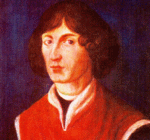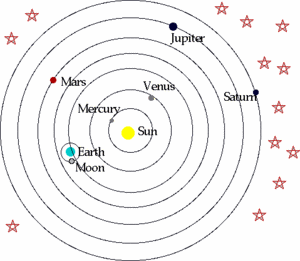Nicolaus Copernicus
A Polish scientist named Nicolaus Copernicus (Polish:Mikołaj Kopernik, 1473-1543) published a model of the solar system that combined the heliocentrism of Aristarchus with the epicycles of Ptolemy. "Finally we shall place the Sun himself at the center of the Universe. All this is suggested by the systematic procession of events and the harmony of the whole Universe, if only we face the facts, as they say, 'with both eyes open.'"
Many have misinterpreted Copernicus' theory to misattribute the Copernican Principle to him. This viewpoint states that the Earth has no special place in the universe.
Copernicus worked for years on his book describing his theory, and published it near the very end of his life. He entitled it, "De revolutionibus orbium coelestium" ("On the Revolutions of the Heavenly Spheres"), and published it in 1543. The major parts of Copernican theory are:
- Heavenly motions are uniform, eternal, and circular or compounded of several circles (epicycles).
- The center of the universe is near the Sun.
- Around the Sun, in order, are Mercury, Venus, Earth and Moon, Mars, Jupiter, Saturn, and the fixed stars.
- The Earth has three motions: daily rotation, annual revolution, and annual tilting of its axis.
- Retrograde motion of the planets is explained by the Earth's motion.
- The distance from the Earth to the sun is small compared to the distance to the stars.
Copernicus was able to estimate the distances of the planets to the Sun, relative to the Earth's distance to the Sun, and correctly gave the order of the planets in distance to the Sun. Aristarchus was only able to compute the distance from the Earth to the Moon, and the radius of the Moon, and to crudely estimate the Earth's distance to the Sun. Copernicus also estimated the sidereal length of the Martian year.
The reception to his work was initially positive within the Catholic Church. Years later, the Church reconsidered in connection with claims by Galileo that the Copernican model had been proven correct. Copernicus' book was suspended until corrected by the Index of the Catholic Church in 1616, because the Pythagorean doctrine of the motion of the Earth and the immobility of the Sun "is false and altogether opposed to the Holy Scripture". [1] [2] These corrections were indicated in 1620, and nine sentences had to be either omitted or changed.[3] The book stayed on the Index until 1758. In the 20th century, scientists adopted a view closer to the Church scientists. The consensus is now that motion is relative, that Earth-centered and Sun-centered coordinate systems are equally valid for astronomical calculations, that Galileo's main argument for the Copernican system was fallacious,[4] and that the doctrine of the immobility of the Sun is false.[5]
Copernican Revolution
Copernicus's book title used the word "revolution" in the sense of planets revolving around the Sun, not in the sense of an intellectual revolt. In the late 20th century, the term Copernican Revolution has come to mean the prototypical paradigm shift, where scientists suddenly became enlightened by rejecting the prejudices of their predecessors.
In fact the Copernican theory was no more accurate than the Ptolemaic model. It had no compelling physical arguments for its superiority, and it proposed no experiments for testing its novel features. In some respects, it was actually less accurate, as more epicycles had to be added (in place of Ptolemy's equant). Copernicus' main argument in favor of his theory was that it was aesthetically more pleasing as it allowed the planets to move in uniform circular motion, an idea later proven false by Kepler. Many of the ancient Greek arguments for and against heliocentrism remained unresolved for some time. [6]
Notes
- ↑ Decree of General Congregation of the Index, March 5, 1616 (Translated from Latin)
- ↑ Trial of Galileo [1]
- ↑ Catholic Encyclopedia [2]
- ↑ Galileo argued that the motion of the Earth caused the tides.
- ↑ The Sun orbits around a black hole at the center of the Milky Way galaxy.
- ↑ Ancient Greeks objected to Aristarchus's heliocentrim because (1) we don't feel the Earth's motion, (2) unattached objects don't fly off, and (3) no annual stellar parallax. [3] Stellar parallax was not measured until 1838, while (1) and (2) were resolved by the work of Isaac Newton.

